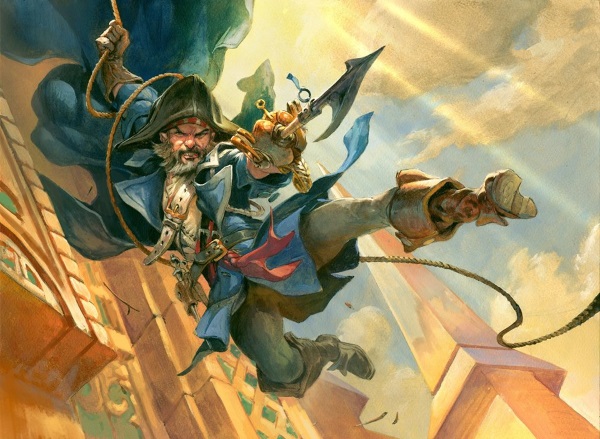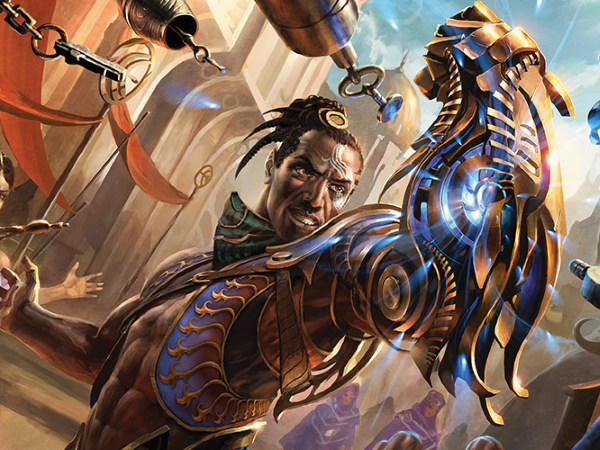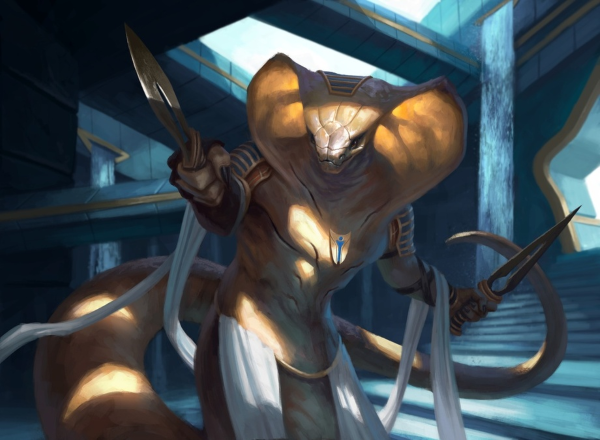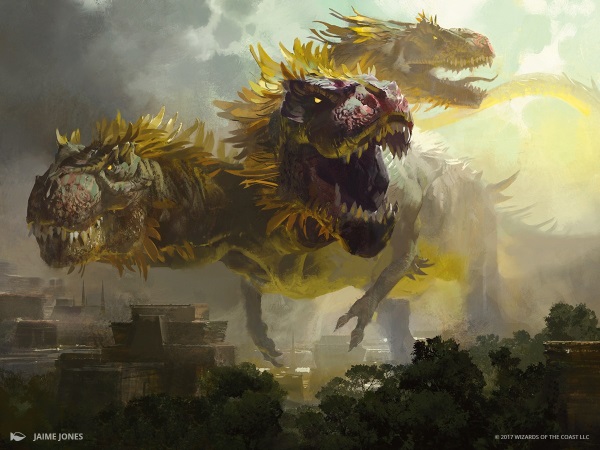Magic: The Gathering is a flexible creature, but it’s not every day that a new format is born. Straight from the wizard’s mouth comes Brawl, a novel casual format that looks a little like Standard and a little like Commander depending how the light hits it. Today’s article is going to cover what Brawl is, who it’s for, how to build for it, and my take on the format’s outlook.
What is Brawl?
At its core, Brawl is the offspring of Standard and Commander. It’s a casual format like Commander, but stores will also be able to hold sanctioned Brawl tournaments if they choose. Brawl is intended to be a multiplayer format like Commander and has its own set of deck construction and gameplay rules. They can be found in Gavin Verhey’s article about the format, but I’ll reiterate them here:
- Each player's deck is exactly 60 cards. Other than basic lands, no card may appear in a deck more than once. Each card must be legal in the Standard format; cards banned in the Standard format can't be played in the Brawl variant.
- Before the game begins, each player designates one legendary creature or planeswalker card in their deck as their commander. This card begins the game in the command zone and the other 59 cards are shuffled up.
- The mana symbols that appear on your commander dictate what cards may be in your deck. Mana symbols that don't appear on your commander can't be in the deck. For example, if the Dominaria card Firesong and Sunspeaker is your commander, your cards may have R, W, both, or neither, but no B, G, or U symbols may appear anywhere in your deck. This includes the card's text box as well as its mana cost; for example, Pride Sovereign from the Hour of Devastation set can't be in your deck if your commander has only G in its cost and rules text.
- Each player begins the game at 30 life rather than 20. If you're playing a multiplayer game, each player draws seven cards again on their first mulligan and the player who plays first draws a card on their first turn.
- As long as your commander is in the command zone, you may cast it from there. Doing so costs an additional two mana for each time you have cast the card this way this game.
- If your commander is countered, leaves the battlefield, or would otherwise change zones, you may put it back into the command zone instead of putting it anywhere else it would go.
If you’re familiar with Commander, Brawl seems a lot like Commander-Lite (Now with fewer calories!). The singleton style, color identity rules, and commander-specific gameplay borrow heavily from the popular highlander format. Standard contributes a card pool, its associated banlist, deck size, and rotation. If you’re familiar with Standard, Brawl seems a lot like Trade Binder Standard (Now with more players!).
That’s a lot of jargon about what Brawl is, but what does it all mean for the format? What might Brawl look like? How will games of Brawl feel?
My first impression is that Brawl is going to play a lot like regular old kitchen-table Magic. It’s going to feel like when you first started playing the game and didn’t have playsets of Standard staples or combos constructed from the most powerful cards in history. That loose, free-wheeling feeling is Brawl’s biggest strength. This is a format that prioritizes having a fun, engaging experience with other players that doesn’t hinge on income or experience. The limited card pool and deck construction rules put every player on more equal footing.
Commander has a longtime issue of power level between strangers. Your tuned turn-four combo deck with Sidisi, Undead Vizier isn’t going to be fun to play against with my Momir Vig, Simic Visionary Frog Tribal deck. Standard, like all competitive constructed formats, has decks that sometimes just lose to other decks. Brawl solves both of these issues by having a flatter power level and multiple players.
If you’re interested in getting into Brawl but are only familiar with Standard or Commander, then this format is going to have some quirks you’ll need to plan for. I want to examine Brawl’s unique rules from each of these starting points. What differences should Standard and Commander players expect when getting into this new format?
Coming from Standard
Standard is a format that often rewards clever deckbuilding and metagaming. It’s a format that doesn’t have a singleton rules, and games of Standard involve one-on-one play. If you’re familiar with Standard and want to try out Brawl, here are some tips for success.
Tip #1: Singleton formats have higher variance.
The most radical shift for Standard players is going to be the lack of playsets in decks. You don’t get your 4x Ahn-Crop Crasher anymore. Say good-by to closing out games by casting Torrential Gearhulk the turn after you cast Torrential Gearhulk. You’re going to have to get used to a deck with less consistency and learn how to mitigate that.
The easiest way to build a singleton deck is to focus on mana curve over card impact. You’re going to have to play cards that look worse than other cards, especially with Standard’s smaller cardpool. It will also be more difficult to assemble powerful combinations of cards. Make sure you hit your land drops, have enough spells at each mana cost, and find any way you can to improve the quality of your draws. Card draw spells, scrying and related filtering mechanics, and tutors will go a long way (While I generally advise against tutors in Commander, they will do far less damage in a format like Brawl with weaker cards and weaker combos.)
The color identity rule will also likely trip up Standard players, as you can’t splash to fill in missing effects in Brawl. If you’re playing a red/green deck, sorry, you don’t get counterspells to protect your creatures. Want Nezahal, Primal Tide as your commander? Prepare to eschew sweepers and spot removal. Look towards artifacts for mana ramping if you’re not in green, and remember to pack enough copies of your essential effects for whatever your deck’s plan is.
Tip #2: Multiplayer games require politicking.
In one-on-one games of Magic, you don’t have to worry about taking game actions that might disgruntle your opponent; they’re already devoting every game action towards vanquishing you. In multiplayer games, earning the ire of your opponents is often an express lane to defeat. If you want to win at Brawl, be conscious of how your game actions impact how your opponents view your threat level.
Beyond just trying to tick up your win percentages, multiplayer Magic involves the social contract. Standard is about defeating your opponent in whatever fashion you think works. Multiplayer games tend to be more casual, and your top priority should be ensuring that everyone is having fun. If you’re taking actions that make people not want to play with you, you won’t have anyone to play with.
The key to successful multiplayer games is communication. If you think your deck might be too strong or too weak, talk with the other players before the game even starts so that you can all discuss your expectations for the game. Rely on goodwill to form alliances during a game. Avoid needlessly causing opponents to feel bad. My best advice from Commander is to give everyone at least an opportunity to “do their thing” with their deck. It’s not a hard rule, but a good guideline when considering who to attack or eliminate from the game.
Tip #3: Multiplayer games are slower
This point refers to both the number of turns that the game will last and the actual time it takes to finish a game. For Standard players, a number of changes with Brawl contribute to this.
First, each player starts with 30 life. In Standard, you usually win by dropping your opponent’s life from 20 to 0. In Brawl, you have to inflict 30 points of damage instead of 20, and have multiple opponents to defeat. That takes longer and makes it harder to build a purely aggressive deck. The good news is that you’re not the only player attacking. Remember from the last tip, your alliances in a game will help aim damage from other players where you want it to go.
Second, every one of your creatures will face down three times as many removal spells as in a typical game of Standard. This also contributes to the difficulty aggro decks have in a format like Brawl (and Commander). You won’t see mono-red decks dominate Brawl like they can in Standard. Make sure your deck has plans for the long game. Look for ways to recur your best cards. Put more focus on amassing resources than you’re comfortable with, especially lands and cards. The player that wins is often the one that does the more powerful things, not the fastest things.
Overall, Brawl feels more like Commander than Standard, so that’s going to be a big adjustment to move from Standard to Brawl. But I think the deck construction restrictions make Brawl an enticing format for Standard players who love brewing new decks. The casual multiplayer format also makes games a bit more relaxing than the more competitive nature of Standard.
Coming from Commander
It’s easy to look at Brawl and think it’s just a dumbed-down version of Commander. Instead of being melodramatically negative about it, look at it as a Commander variant with more intense deck construction rules. The different cardpool, deck size, and life totals offer new vectors to contemplate when building a new deck. If you’re a long-time Commander player, however, these new restrictions can be a little tricky. Here are some tips if you want to give Brawl a shot.
Tip #1: Ratios stay similar at smaller deck sizes, but caveats always apply.
Build enough Commander decks and you start to get a feel for how many lands, creatures, and spells you want to play in a 100-card deck. Brawl decks are only 60 cards, however, and that can scramble much of your internalized math. The key is to keep your ratios similar, but also understand that they’re less granular than before.
For example, the average Commander deck runs 37-40 lands. For Brawl, the same ratios say to play 23-24 lands. The caveat is that you’ll generally have less access to mana ramp, card draw, and help from artifacts. My baseline recommendation for Brawl would be to play 25 lands. Like Commander, hitting all your land drops is one of the most important things you can do to win a game. If you’re not playing green, you’ll have a hard time ramping. Don’t be afraid to play a higher percentage of lands in Brawl than Commander.
Otherwise, 60-card decks look fairly similar to 100-card ones. You’ll probably want 20-28 creatures unless you’re a controlling deck. If you’re hard on control, you may even only want 3-5 creatures (other than your commander) to finish a game once you’ve seized control of it. That can be very uncomfortable at first glance when you’re used to having so many card slots. This also related to the next tip:
Tip #2: Smaller decks are more streamlined and have less room for weird stuff.
Commander is a high-variance format, and most players will fill out decks with funky one-off effects that they enjoy. If you’re going to build a deck for Brawl, you have to learn to kill your darlings. With 40 fewer slots, you can’t often afford to play effects that don’t further your deck’s strategy. Brawl has lower variance than Commander, so you won’t always want to be drawing your weird cards instead of your good cards.
That said, more focused decks might be a positive for some players. Commander can sometimes feel bloated, and some themes might not have enough pieces to fill out a 100-card deck. For example, it’s more difficult to build a deck around the energy mechanic from Kaladesh and Aether Revolt in Commander. There just aren’t enough high-impact energy cards to make a deck run as smoothly as some players would like. Brawl’s smaller decks make these kinds of mechanics easier to build around. Decks that might not have enough juice to compete in Commander are great candidates for Brawl.
Tip#3: Brawl will feel weaker. Accept this as a good thing.
Commander decks are constructed from a cardpool that includes some of the most powerful Magic cards ever printed. Because Brawl is limited to Standard, your deck is going to feel about as powerful as a Standard deck. This might be a turn-off for some Commander players looking to explore a new format, but there are many positives here.
I mentioned Brawl’s flatter power level earlier, and I think this is going to be one of the pillars of the format’s success. The difference between the most powerful and weakest decks in Brawl is going to be much smaller than the same gap in Commander. That puts every player on more equal footing, which often leads to more enjoyable games for everyone. Wonkier decks have an opportunity to work better. Competitive players have a better testing ground to prove their skills. A reduced worry about powerful cards and combos allows players to relax and enjoy each other’s company more.
More even deck power makes finding games easier too, as you’re less likely to encounter players with decks that don’t match your power level.
One thing that does mitigate weaker decks is the lower starting life total. While a 2/2 might not have much of an impact in a game of Commander, it’s more powerful in a game where players start at 30 life instead of 40. This will help move games along faster and prevent too much durdling. This can make cards feel more powerful in the context of Brawl even when they’re weaker in a vacuum.
Tip #4: Don’t get too attached to your deck.
Brawl takes one key component from Standard: a rotating card pool. That means your options will change once a year with the release of the large third-quarter set. Commander players don’t have to deal with rotation, as it’s an eternal format.
If you’re the kind of Commander player who enjoys variance, Brawl’s rotations will help keep the format fresh for you. This is also important since the overall cardpool is smaller. This makes it easier to come and go from Brawl whenever you want, as the cardpool will never grow too large to manage.
Rotation is where a lot of Brawl’s balance comes from. This is a feature, not a bug, and helps give cards use beyond Standard and Modern and Commander. A rotating singleton format means you’ll always have a place to play the random cards you open at prereleases or in drafts or just cracking packs. Cards won’t have to rot in storage and trade binders, as Brawl is a format where almost anything in Standard is worth playing. To me, that’s going to be one of the defining facets of Brawl as a format.
For Commander players, I think Brawl’s biggest selling point is its nimbler gameplay and easier-to-acquire cards. Rotation removes a large incentive for foil cards, helping reduce the overall cost of decks. The restricted cardpool also gives brewers even more restrictions to play around in, which is something that’s always important to me as a deck builder. More streamlined games in a format that offers more variance over time make for an exciting environment for Commander fans to explore.
For Your Consideration
That’s a lot to think about regardless of what format you’re coming from! I thought it might be helpful to provide a sample Brawl deck and explain the choices I made for it in the context of the above tips. If I’m going to jump into Brawl, I’m going to go big or go home. Here’s Zacama, Primal Brawler:
While I dabble in Standard, I’m predominantly a Commander and limited player. This deck reflects a lot of how I think about Commander as a format and how I can translate that to success in Brawl. The goal here is to go over the top of everyone else and blast some faces in with Zacama, Primal Calamity. Zacama makes a great Brawl commander because they allow me to play three colors to maximize my card options in this singleton format.
Zacama requires a lot of work though. At a whopping nine mana, a deck needs to put in effort into even being able to cast Zacama let alone survive long enough to do so. Once Zacama hits the battlefield, however, their three abilities can control the board and keep me alive long enough to win.
The main problem these colors have, however, is that they lack reliable ways to draw more cards. In order to mitigate this weakness, I wanted to use the explore mechanic to help at least maximize the chance that I’ll hit my land drops every turn so I can cast Zacama. Explore is a mechanic found on creatures, so this helped push the deck to embrace a dense creature count than most controlling ramp decks.
This also fits in with multiplayer philosophy. The more creatures I have gumming up the board, the harder it is for my opponents to attack me. If I’m not an easy target, they might swing elsewhere to get better combat results. Creatures like Ripjaw Raptor and Regal Caracal help dissuade attacks.
My first approach of the Brawl format involves calling upon the power of impressive late-game threats, but that’s far from the only way to build in this format. Samut, Voice of Dissent lends herself to a mighty beatdown deck. The Scarab God can play the long-term incremental value game. Azor, the Lawbringer seems fantastic for a classic control deck.
Pick whichever Standard-legal legendary creature or planeswalker speaks to you and get brewing!
That’s Brawl, Folks
Overall, I really like the potential for Brawl as a format. Every format has its daunting aspects, and Brawl does a great job at mitigating these factors for two of the most popular formats in Magic, Standard and Commander. If you’re concerned about the cost of Standard, Brawl allows you to play with powerful cards without needing four copies of them. If Commander’s huge cardpool and complicated interactions are daunting, Brawl narrows those down into manageable bits of information.
If you’re not familiar with either Standard or Commander, Brawl also works well as an intermediate format that can lead to either. All Brawl decks are legal in Standard and provide a skeleton for a more competitive deck. If a player chooses, they can begin adding cards to their Brawl deck until it’s 100-cards for Commander. That flexibility is a quality that I like about Brawl.
Finally, there’s the Arena element. Commander is popular, but programming every card in Magic takes an awful lot of time and work. Brawl works as a fantastic variant singleton format that can easily be programmed into digital games like Arena. We already know that Brawl will be coming to Magic: The Gathering Online with the release of Dominaria. I think it’s only a matter of time until Brawl comes to Arena as well.
Speaking of Dominaria, that set is going to be loaded with new legendary creatures and planeswalkers to build Brawl decks around. I’m excited about the potential of this new format and hope today’s article helped explain the neat things that it offers to players old and new.
Thanks for reading, and make sure to check out our new Brawl Forum for strategy, deckbuilding, and general discussion with other players!




-
View User Profile
-
Send Message
Posted Mar 26, 2018-
View User Profile
-
Send Message
Posted Mar 26, 2018